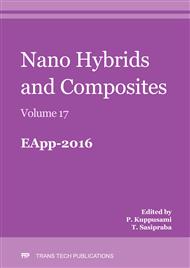[1]
P.G. Bruce, Solid State Electrochemistry, Cambridge University Press, Cambridge, (1995).
Google Scholar
[2]
F.M. Gray, PolymerElectrolytes, RSCMonographs, The Royal Society of Chemistry, London, (1997).
Google Scholar
[3]
N. Choi, J. Park, New polymer electrolytes based on PVC/PMMA blend for plastic lithium-ion batteries, Electrochim. Acta 46 (2001)1453-1459.
DOI: 10.1016/s0013-4686(00)00739-8
Google Scholar
[4]
D.E. Fenton J.M. Parker P.V. Wright, Complexes of alkali metal ions with poly(ethylene oxide), Polymer 14 (1973) 589.
DOI: 10.1016/0032-3861(73)90146-8
Google Scholar
[5]
Young-G Lee, Jung-Ki Park, Electrochemical characteristics of polymer electrolytes based on P(VdF-co-HFP)/PMMA ionomer blend for PLIB, Journal of Powersources 97-98 (2001) 616-620.
DOI: 10.1016/s0378-7753(01)00575-4
Google Scholar
[6]
J.M. Tarascon,M. Armand, review article Issues and challenges facing rechargeable lithium batteries, Nature 414 (2001) 359-367.
DOI: 10.1038/35104644
Google Scholar
[7]
A.S. Arico, P.G. Bruce, B. Scrosati, J.M. Tarascon, W.V. Schalkwijk, Nanostructured materials for advanced energy conversion and storage devices, Nat. Matter 4 (2005) 366-377.
DOI: 10.1038/nmat1368
Google Scholar
[8]
D.J. Bannister G.R. Davier, I.M. Ward, J.E. MCIntyre, Ionic conductivities for poly(ethylene oxide) complexes with lithium salts of monobasic and dibasic acids and blends of poly(ethylene oxide) with lithium salts of anionic polymers, Polymer 25 (1984).
DOI: 10.1016/0032-3861(84)90378-1
Google Scholar
[9]
D.W. Kim J.K. Park H.W. Rhee, Conductivity and thermal studies of solid polymer electrolytes prepared by blending poly(ethylene oxide), poly(oligo[oxyethylene]oxysebacoyl) and lithium perchlorate, Solid State Ionics 83 (1996) 49-56.
DOI: 10.1016/0167-2738(95)00238-3
Google Scholar
[10]
C. Robitaille, J. Prud'homme, Thermal and mechanical properties of a poly(ethylene oxide-b-isoprene-b-ethylene oxide) block polymer complexed with sodium thiocyanate, Macromolecules 16 (1983) 665-673.
DOI: 10.1021/ma00238a033
Google Scholar
[11]
J.E. Weston, B.C.H. Steele, Effects of inert fillers on the mechanical and electrochemical properties of lithium salt-poly(ethylene oxide) polymer electrolytes, Solid State Ionics 7 (1982) 75-79.
DOI: 10.1016/0167-2738(82)90072-8
Google Scholar
[12]
A. Subramani, N.T. KalyanaSundaram, A. RohiniPriya, R. Gangadharan, T. Vasudevan, Preparation of a microporous gel polymer electrolyte with a novel preferential polymer dissolution process for Li-ion batteries, J. Appl. Polym. Sci. 98 (2005).
DOI: 10.1002/app.22114
Google Scholar
[13]
Z.L. Wang, Z.Y. Tang, A novel polymer electrolyte based on PMAML/PVDF-HFP blend, ElectrochimActa 49 (2004 1063-1068.
DOI: 10.1016/j.electacta.2003.10.017
Google Scholar
[14]
A. Rincon, I.C. McNeill, Thermal degradation of poly(methyl methacrylate)-poly-4-bromostyrene blends and methyl methacrylate-4-bromostyrene copolymers, Polym. Degrad. Stab. 40 (1993) 125-135.
DOI: 10.1016/0141-3910(93)90202-t
Google Scholar
[15]
Sung HY, Wang YY, Wan CC, Preparation and Characterization of Poly (vinyl chloride‐co‐vinyl acetate) ‐based Gel Electrolytes for Li‐Ion Batteries, J ElectroChem. Soc. 145 (1998) 1207-1211.
DOI: 10.1149/1.1838440
Google Scholar
[16]
S. Ramesh, A.H. Yahaya, A.K. Arof, Dielectric behaviour of PVC-based polymer electrolytes, Solid State Ionics 152-153 (2002) 291-294.
DOI: 10.1016/s0167-2738(02)00311-9
Google Scholar
[17]
B. K. Choi Y.W. Kim, H. K. Shin, Ionic conduction in PEO-PAN blend polymer electrolytes, ElectrochimicaActa 45 (2000)1371-1374.
DOI: 10.1016/s0013-4686(99)00345-x
Google Scholar
[18]
R. Subadevi, M. Sivakumar , S. Rajendran, Hung-Chun Wu , Nae-Lih Wu, Development and characterizations of PVdF-PEMA gel polymer electrolytes, Ionics 18 (2012) 283-289.
DOI: 10.1007/s11581-011-0629-0
Google Scholar
[19]
S. Rajendran, M. RameshPrabhu, Effect of different plasticizer on structural and electrical properties of PEMA-based polymer electrolytes, J. Appl. Electrochem 40 (2010) 327-332.
DOI: 10.1007/s10800-009-9979-y
Google Scholar
[20]
E. Quatarone, P. Mustarelli, A. Magistris, PEO-based composite polymer electrolytes, Solid State Ionics 110 (1998) 1-14.
Google Scholar
[21]
K. Tsunemi, H. Ohno, E. Tsuchida, A mechanism of ionic conduction of poly (vinylidene fluoride)-lithium perchlorate hybrid films, ElectrochimActa 28 (1983) 833-837.
DOI: 10.1016/0013-4686(83)85155-x
Google Scholar
[22]
Mac Callum JA, Vincent CA(1987) polymer electrolyte reviews-I, Elsevier Applied Science, London.
Google Scholar
[23]
R. Baskaran, S. SelvasekaraPandian, N. Kuwata, J. Kawamura,T. Hatton, ac impedance, DSC and FT-IR investigations on (x) PVAc–(1−x) PVdF blends with LiClO4, Materials Chemistry & Physics 98 (2006) 55-61.
DOI: 10.1016/j.matchemphys.2005.08.063
Google Scholar
[24]
N.S. Choi, Y.G. Lee, J.K. Park, J.M. Ko, Preparation and Electrochemical characteristics of the Plasticized Polymer electrolyte based on P(VdF-co-HFP)/PVAc blend, Electrochimica Acta 46(2001)1581-1586.
DOI: 10.1016/s0013-4686(00)00756-8
Google Scholar
[25]
C.H. Kim, K.H. Lee, W.S. Kim, J.K. Park, D.Y. Sung, Ion conductivities and interfacial characteristics of the plasticized polymer electrolytes based on poly(methyl methacrylate-co-Li maleate), J. Power Sources 94 (2001) 163-168.
DOI: 10.1016/s0378-7753(00)00579-6
Google Scholar
[26]
J.B. Wagner, C. J. Wagner, Chem. Rev., 26 (1957) 1597.
Google Scholar
[27]
Adachi K, Urakawa O, Dielectric study of concentration fluctuations in concentrated polymer solutions J. Non-cryst. Solids, 307-310 (2002) 667-670.
DOI: 10.1016/s0022-3093(02)01527-2
Google Scholar
[28]
J. Perez and O. Manero, Mechanism of ionic conductivity for zwitterionic polymers, Polymer 1998, 39(26) 6969-6975.
DOI: 10.1016/s0032-3861(98)00091-3
Google Scholar
[29]
Jonscher AK, Dielectric relaxation in solids, Chelsea Dielectric, London, 1983, 284.
Google Scholar
[30]
JonscherAK, Analysis of the alternating current properties of ionic conductors,J. Mater. Sci., 13 (1978) 553-562.
Google Scholar
[31]
K.A. Mauritz, Dielectric relaxation studies of ion motions in electrolyte-containing perfluorosulfonate ionomers. 4. Long-range ion transport, Macromolecules, 22 (1989) 4483-4488.
DOI: 10.1021/ma00202a018
Google Scholar
[32]
U. S. Park, Y.J. Hong, S. M. Oh, Fluorescence spectroscopy for local viscosity measurements in polyacrylonitrile (pan)-based polymer gel electrolytes, Electrochim. Acta 41 (1996) 849-855.
DOI: 10.1016/0013-4686(95)00372-x
Google Scholar


